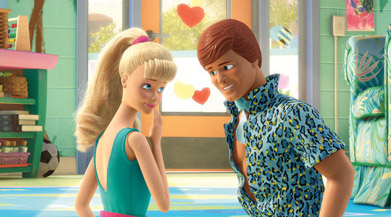|
|
Make an ArgumentRevisiting Toy Story 3By Eric HughesJuly 13, 2011
Now, I’ve been out of college for a few years already, but the overheard storyline resonated with me. I loved that Pixar would be tackling lost, youthful innocence as inevitable aging sets in. Turns out I had all my eggs in the wrong basket. Andy didn’t factor into the movie nearly as much as I expected him to, and thus, scenes with the toys (i.e. the whole movie) felt like they ran real long. I was waiting for Andy to reappear to ground the film in what it means to grow up. What I missed, then, was that you get much of that anyway through interactions among the toys as they come to realize they’re no longer as important as they once were. That whole thing might seem trivial, but when films don’t meet expectations, they can become burdensome to watch. So, watching Toy Story 3 a second time, I had a better idea of what I was going to see, and wasn’t caught off guard by those same, incorrect expectations. That out of the way, I found myself enjoying Toy Story 3 immensely. It’s rich in comedy and heart, and didn’t suffer so much under the shadow of sequelitis as I claimed it did last time ‘round. New characters were mostly a delight, and good thing, too, as they underwent the most development. Lotso, as it were, went from the jolly “I’m a hugger!” pink giant to a moody, aggressive baddie. My favorite newbie, though, was the classically trained English dude Woody meets along the way. Barbies in the movie felt gimmicking in theaters, but I read the characters totally differently in round two. Michael Keaton’s Ken was just golden. The detail I missed in theaters was that Barbie belonged to Andy’s sister before she boxed the toy for donation to Sunnyside. So, Barbie and Ken’s meet up at the play center wasn’t so much a reunion from across the hall, but, perhaps, the first time they’d ever met. And framing Ken as a metrosexual (if not a closeted homosexual) was inspired. Ken might be male, but we all know he’s a toy for girls. I’m working off a brain that hasn’t seen a Toy Story in at least a decade, but even then I picked up on a few things included in the movie to mostly treat the fans. I adored “You’ve Got a Friend in Me” playing over the closing credits. And the little green aliens saving the day with a crane – “the claaaaaaw! – was a nice touch, too. I don’t know that Toy Story 3 is any better than the movies that preceded it – it’s been a long, long while since I last saw them – but it’s a worthy closer to an animated trilogy that doesn’t really have a weak spot. So often filmmakers – animators or otherwise – mess up part twos in their efforts to re-work the magic of film one in an original way. Or, filmmakers will knock sequel one out of the park – i.e. Shrek 2 – but then lose that momentum in a dangerous way for parts three and beyond. (See, again, the Shrek franchise). Toy Story, though, is a tight collection of movies that earned its audience - and at a time when Pixar didn’t really have one.
|

|
|
|

|
Friday, November 1, 2024
© 2024 Box Office Prophets, a division of One Of Us, Inc.


